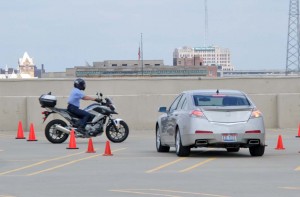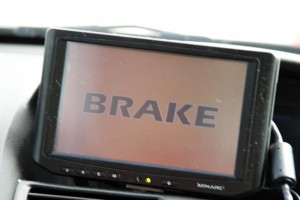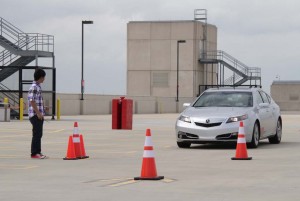
Honda's WiFi-like system can spot motorcycles and pedestrians even when they're out of the line of sight.
While traffic fatalities have fallen sharply over the last decade, deaths involving pedestrians and motorcycle riders have remained stubbornly high. But Honda is experimenting with a new, wireless technology that could significantly reduce those numbers in the years ahead.
And unlike camera, radar and laser-based systems, the Dedicated Short-Range Communications, or DSRC, system the Japanese maker demonstrated this week can track pedestrians and motorcycles even when they’re out of the line of sight – hidden, for example, on the other side of a parked car or around a corner.
The new systems are part of a broader array of Intelligent Transportation Systems that, “we believe will be the next step towards a crash-free car,” said Jim Keller, Honda’s Chief Engineer of Automotive Technology Research.

For now, the two systems trigger visible and aural alarms but could eventually be linked to a vehicle's brakes to allow for quicker stops even if the driver were distracted.
In a demonstration on top of the roof of Detroit sprawling MGM Grand Casino, Honda showed off the two prototype systems by having a motorcycle scoot across an “intersection’ initially hidden from view behind a truck. The driver of a Honda Accord was alerted to the danger by a warning sound and a flashing light on a video display mounted atop the dashboard. A similar test revealed a pedestrian stepping out into “traffic” from behind a van.
Without the added warning the Accord driver might have hit both obstacles. Instead, he had enough time to bring the sedan safely to a stop.
Honda isn’t the only automaker looking for ways to reduce crashes and, in particular, to spot pedestrians stepping into traffic. Volvo’s City Safety technology has won numerous kudos – and discounts from insurers who find it effective at reducing car-to-car and car-to-pedestrian collisions.
But such systems based on cameras or radar, sonar and laser sensors generally can’t do much behind the line of sight, and generally can offer no more than about three seconds of warning. Honda’s Vehicle-to-Pedestrian and Vehicle-to-Motorcycle, or V2P and V2M, technologies can boost that to as much as 10 seconds and spot potential, out-of-sight collisions in the making.
(Volvo prototype can drop you off and then go find a parking spot. Click Here for more.)

The pedestrian detection system would require a person be carrying a specially equipped cellphone - which could eventually become as common as one with Bluetooth or WiFi.
The trick is a WiFi-like wireless communications system. If it proves effective – and if Honda, its competitors and regulators all can agree on standards – a small chip would be embedded in future cellphones and in motorcycles. In a phone, the device would constantly broadcast a low-power signal that would indicate if a pedestrian were getting ready to walk onto the street, while the motorcycle system would indicate the bike’s path.
A wireless receiver in a car like the prototype Accord would constantly be on the watch for potential collisions. And, going forward, such technology could be linked to the vehicle’s brakes, allowing the car to come to a stop, if necessary, perhaps before the driver even recognized the danger.
Federal regulators are studying the idea of requiring similar V2V, or vehicle-to-vehicle, technology in future passenger cars. That could alert a driver entering a sharp curve to problems ahead, such as an oncoming vehicle making a left turn.
(Nissan plans to put autonomous vehicle into production by 2020. Click Here for that breaking story.
Honda is one of a growing number of manufacturers who have set a stretch goal of eliminating traffic fatalities using high-tech systems as well as basic improvements in vehicle crash structures.
On Tuesday, Nissan restated that target as it announced plans to launch its first fully autonomous, or hands-off, vehicle by 2020. The maker said it hopes to offer that technology in all of its products within the following decade.
